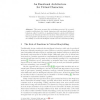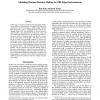202 search results - page 15 / 41 » Modeling collision avoidance behavior for virtual humans |
CHI
2010
ACM
13 years 4 months ago
2010
ACM
Teaching is inherently a social interaction between teacher and student. Despite this knowledge, many educational tools, such as vocabulary training programs, still model the inte...
COST
2010
Springer
13 years 2 months ago
2010
Springer
Abstract. Computational models that attempt to predict when a virtual human should backchannel are often based on the analysis of recordings of face-to-face conversations between h...
STORYTELLING
2005
Springer
14 years 1 months ago
2005
Springer
This paper presents the mechanisms proposed by a generic cognitive architecture for virtual characters with emotional influenced behaviors, called cognitiva, to maintain behavior ...
CVPR
2010
IEEE
14 years 1 months ago
2010
IEEE
Detecting pedestrians in images is a key functionality to avoid vehicle-to-pedestrian collisions. The most promising detectors rely on appearance-based pedestrian classifiers tra...
AAAI
2006
13 years 9 months ago
2006
In this paper we propose a model for human learning and decision making in environments of repeated Cliff-Edge (CE) interactions. In CE environments, which include common daily in...


